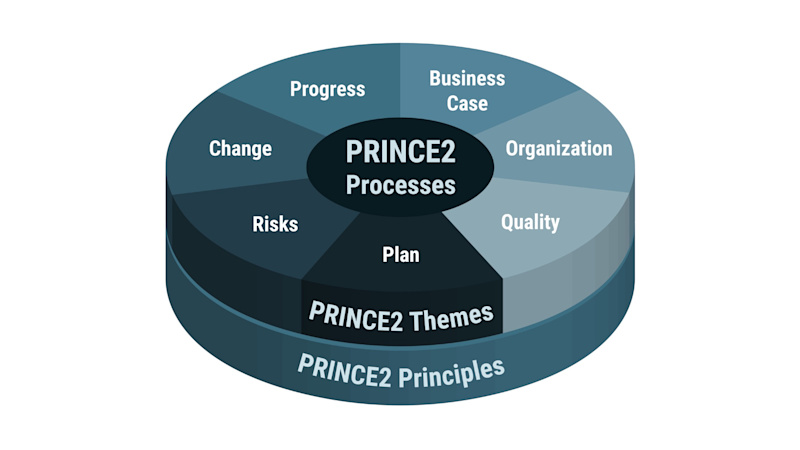In the ever-evolving landscape of project management, staying up-to-date with the latest methodologies and best practices is crucial for success. PRINCE2® (PRojects IN Controlled Environments) has been a staple in the project management field for years, offering a structured framework to manage projects effectively. PeopleCert's release of a new version of PRINCE2, the 7th Edition, marks a significant step forward, incorporating modern practices and addressing the evolving needs of project managers.
We share insights on key features and enhancements in PRINCE2 Version 7.
What is the latest PRINCE2 edition? And what's in it?
The latest version of PRINCE2 is PRINCE2 7th Edition. The updates aim to add a new dimension to the guidance and add value for organisations and individuals alike.
In the new edition, Project Managers can find valuable adaptations and simplification of some of the language and content, to make the methodology and guidance more accessible and relevant for project managers and people who manage projects. But other notable updates are:
A new introduction within the first chapter, which defines what a project is and what project management is
An added ‘people integrated element’ that sits at the heart of the other four integrated elements – the 7 principles, 7 practices (previously called themes), 7 processes, and project context
Four new management approaches form part of the Project Initiation Documentation (PID): called the ‘change management approach’, the 'commercial management approach', the ‘data management approach’, and the 'sustainability management approach'
An additional performance target for ‘sustainability’, on top of ‘benefits, costs, time, quality, scope, and risk’.
Why did they update PRINCE2?
A few factors influenced the evolution of the PRINCE2 methodology in what is now PRINCE2 7h edition. These factors include:
new technologies
the environment and climate change
ethics and changing consumer and corporate attitudes
new Government, national and local regulations
new working practices and remote/hybrid working
Beyond this, individuals need to develop soft skills, including leadership, that the ‘people integrated element’ helps to address.
Another goal for this update is to help increase collaboration with cross-functional project teams, improve communications, enable a better understanding of all stakeholder needs, and help co-create an organisational culture where change is embedded and realised more effectively.
What are the benefits of PRINCE2 7th Edition?
Project managers and project team members can enjoy the following advantages when they update their PRINCE2 certifications to the 7th Edition or start their project management training journey on the latest version of PRINCE2.
A Fresh Approach to Tailoring
One of the standout features of PRINCE2 Version 7 is its enhanced approach to tailoring. Recognising that every project is unique, the new version provides project managers with more flexibility to tailor the methodology to suit their specific project needs.Integration with Other Frameworks
PRINCE2 Version 7 acknowledges this reality by providing guidelines on integrating PRINCE2 with other popular frameworks like Agile and Scrum. This integration empowers project managers to take advantage of the strengths of multiple methodologies, resulting in more efficient and collaborative project delivery.Greater Emphasis on Business Value
While project management involves various technical aspects, the ultimate goal is to deliver value to the business or organisation. PRINCE2 Version 7 emphasises this aspect, guiding project managers to focus on delivering tangible benefits and outcomes. This shift in perspective ensures that projects remain aligned with the organisation's strategic objectives and contribute to its overall success.Updated Guidance on Principles and Themes
PRINCE2 Version 7 retains the foundational principles and themes that have made the methodology effective. But, it brings updates and refinements that reflect the changing landscape of project management. These principles and themes provide a solid framework for project managers to base their decisions and actions upon.Enhanced Resource Management
Effective resource management is critical for project success, and PRINCE2 Version 7 recognises this by providing enhanced guidance in this area. The new version offers more detailed insights into managing resources, whether they're financial, human, or physical. This includes guidelines on optimising resource allocation, monitoring resource utilisation, and addressing potential bottlenecks.Embracing the Digital Era
In the age of digital transformation, project management methodologies must adapt to the rapid changes brought about by technology. PRINCE2 Version 7 acknowledges this shift and guides effectively managing projects in the digital era. This includes insights into managing virtual teams, utilising digital tools, and mitigating digital-related risks.
PRINCE2 7th Edition marks a significant step forward in project management. By combining its proven principles with modern practices and adaptability, this latest version empowers project managers to navigate the challenges of today's projects successfully.
How to renew your PRINCE2 Certification
You can speak to your Lumify Work account manager about renewing your PRINCE2 certification in Australia. If you're just beginning your journey towards being a certified project manager, or if you don't have an account manager, you can get in touch by email at training@lumifywork.com or by phone at 1800 853 276.
View our PRINCE2 courses. You can also explore our 7th Edition course offerings:
PeopleCert is one of the leading players in the global certification industry, partnering with multinational organisations and government bodies to develop and manage globally recognised certification schemes. PeopleCert has delivered millions of exams in over 150 countries.
Lumify Work (formerly DDLS Training) is the largest corporate IT and process training provider in Australia. We have been delivering Project Management training courses since 1999 for the IT industry and top 100 ASX corporations.
Our interactive training and workshops will give you a solid foundation in the concepts, tools and techniques of Project Management. With Lumify Anywhere, students can undertake these studies on-site or online – allowing flexible delivery to suit their personal needs and schedule.
Access our guide to project management frameworks to learn which one can support you as a leader in sustainability. You can also enquire with us about a project management course today.








